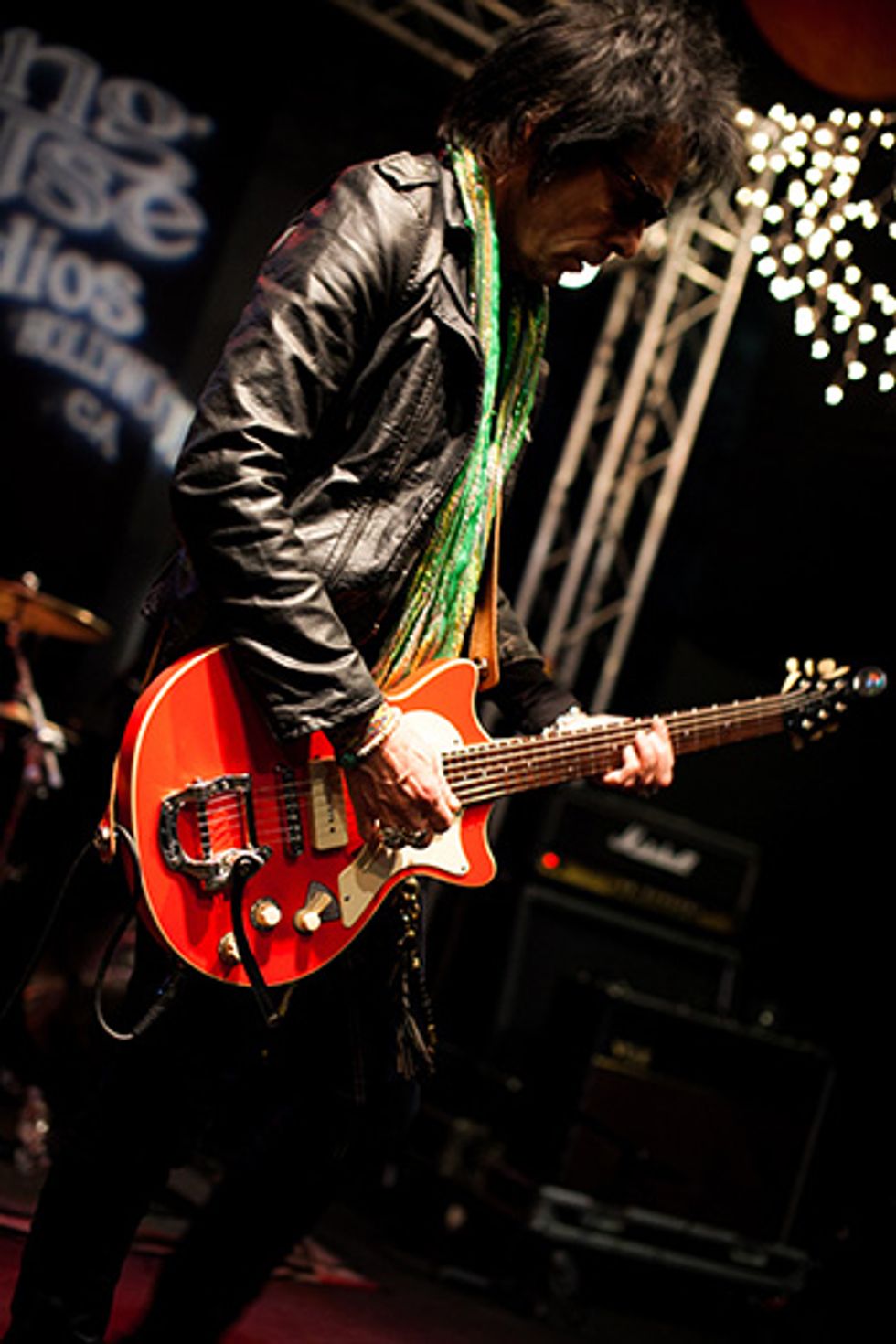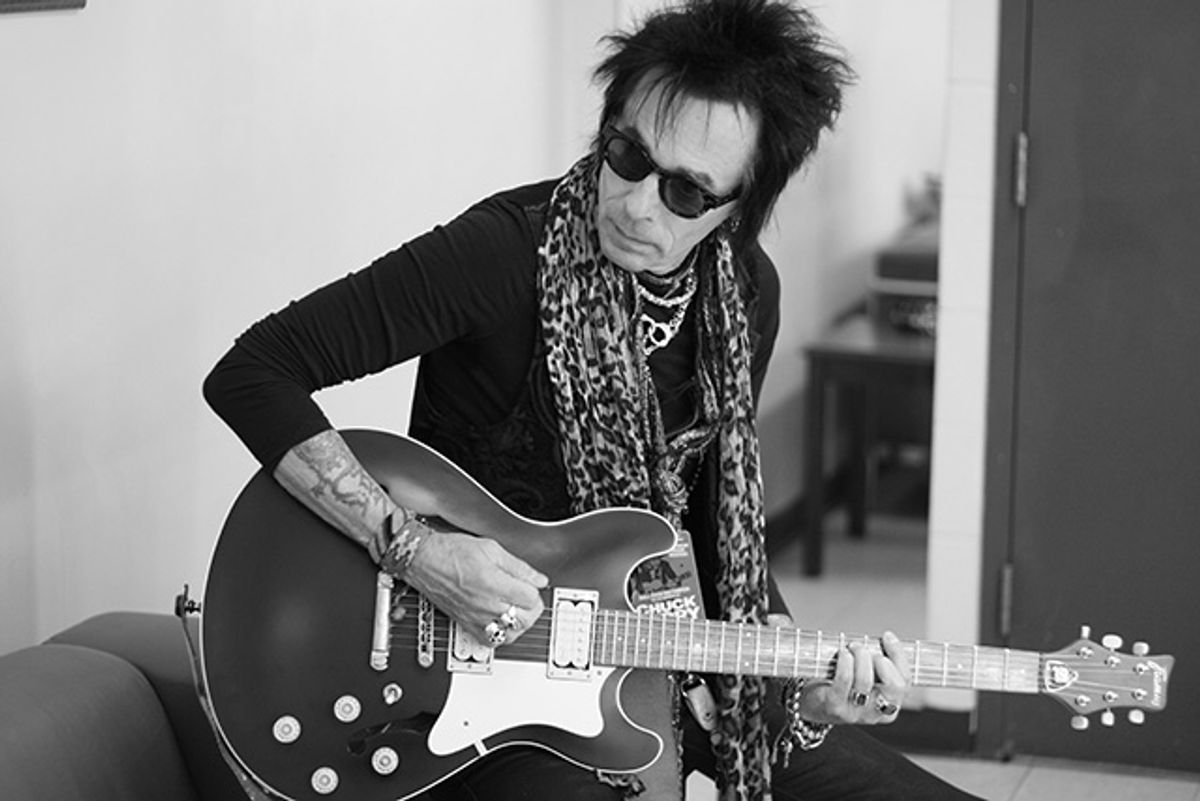Slick discusses working with Bowie for most of his adult life, what to expect from a Bowie album, and what gear he''s digging on at the moment.
A new David Bowie album is always a big deal, but especially when it comes 10 years after the last one. On January 8, 2013, Bowie announced he'd recorded a whole new album, in secret, for release in March. A couple of months earlier, UK paper The Telegraph ran an article which speculated—but really just flat out stated—that Bowie had retired from music altogether. At that point The Next Day was all but finished. It's an album of classic Bowie in the Scary Monsters/"Heroes" mold, with occasional flashes of Let's Dance, Heathen, Reality and even Tin Machine and Outside. Yet like all Bowie productions, after a few listens it begins to distance itself from comparisons and to truly become, simply, the new Bowie album.
Earl Slick—who's played on no fewer than 10 Bowie albums—is one of several guitarists to appear on The Next Day, popping up on various tracks to lend his Keith Richards-esque melodic rock edge to some of the harder material, while Gerry Leonard and David Torn handle some of the more atmospheric songs. But with rumors of Bowie's retirement swirling, did Slick ever think he'd see the day when he'd record another Bowie album? "The situation is kind of funny," Slick says. "I've known David almost my entire adult life and there isn't anything he's ever done that has surprised me. My thought was, 'I'm just gonna go about my business, because he may or many not do something again.' I had no idea, 'cause I'd never seen him go this long. Ever. I couldn't gear what I was doing towards whether he was going to do this again, because I knew he may do it or he may not do it. So I wouldn't have been surprised if he never did it again, and I wasn't surprised when he did do it!"
The album's widely circulated first single, "Where Are We Now?," is not a representation of the work as a whole, Slick says. "[The album is] eclectic. There are definitely some rockers on there, and there are some songs on there that are really reminiscent of different periods of time." But as Slick points out, that's always been Bowie's style. "If you take any Bowie record, you can look at elements that might have come from previous recordings. That also comes from the fact that he is a writer that writes a certain way, even though the material can vary widely. You can listen to Heathen—it's very different to a lot of his other work, but then again, you can hear the influences in there."
"It's like a Stones album," Slick continues, drawing a comparison to one of his guitar touchstones. "If you go back to the very beginning, they were doing covers, and when you come to the present day, those elements are still there. It's the same thing with the Bowie record. There are some really good rockers, there are a few more ethereal-sounding things on there … it's a Bowie record!" Slick likens it to Station To Station saying that the title track was, "fucking insane, with two crazy people doing all this feedback stuff going into a heavy, slow, ominous song, yet on the same album you've got 'Wild Is the Wind.'"
During Bowie's A Reality Tour in 2003-04, Slick was paired up with Gerry Leonard, who served as musical director for the tour and was responsible for reinterpreting much of the Robert Fripp/Reeves Gabrels-era material for live performance. It's a style that Leonard conjures several times during The Next Day. "We weren't in the studio at the same time," Slick says, "so I only know what he'd already done on the tracks I'd recorded! It works really well in the studio and live. But what Gerry can do, though, is if we're doing a track like "Diamond Dogs," for instance, he can do the weaving on the other end. There's a great clip of that [song] in 2004 in Long Island. It's a very Stones-y kind of song anyway, but Gerry can do that as well. He's a very versatile guitar player."

Photo courtesy Madeloni Photography.
Slick's guitar army for The Next Day was mainly led by his Framus signature model, loaded with a pair of P-90 pickups and a Bigsby vibrato. A Framus Mayfield—a 335-style semi-hollowbody—also made a few appearances. "I'd say the Slick model got used the most, and then the Mayfield, and I think I used a Tele on one of them—a '72 Custom Shop reissue." His acoustic guitar for the album was a Gibson 75th Anniversary J-200.
Slick's amp requirements are refreshingly straightforward and direct, considering the sheer breadth of material he might be called on during the course of any given night. Lately he's taken a shine to 65Amps, and recently made an appearance at that company's NAMM party with Mike Campbell & The Dirty Knobs and Orianthi. "I look for a reactive amp," he says. "I like punch and clarity but still with enough cut and balls. Primarily, if it was up to me I'd do one solo a year. I just love playing rhythm guitar. I have an old Ampeg VT-40 here that I just love. It's so percussive and punchy. I also use Orange amps, but I do look for presence in an amp, something that's very reactive to the guitar, because I use my guitar to change my tones, rather than using a lot of pedals to do it."
Cascaded gain stages are a big no-no if you're trying to nail Slick's sound. "If you play through an amp that's set like that, you can't tell the difference between a Tele and a Les Paul," he laughs. "Y'know, when they overdrive the amp so much that there's no way, because you're basically running the preamp so hot that you can't get the sound of the fretboard through it. It just won't translate. I run my amps almost on 10, and I'm futzing with my guitar's volume all the time. It's not even conscious. I want more dirt, I turn the volume up. I want more punch, I turn it down. But you need the right amp to do that with."
As for the Framus, it's a decidedly retro-themed guitar, from both a visual and technical perspective. "I was after something that was gonna give me Gibson and Fender qualities, but with a Gibson scale neck as opposed to a longer Fender scale neck. And I had the neck bolted on, which is going to give you a little more percussiveness and a little more high end. I have that model with humbuckers as well as P-90s, but most of the time I'm using the P-90s." At the moment those pickups are all DiMarzios, but Slick is working on a signature P-90 set with GFS Pickups. "It's guitarfetish.com—the same company I have my Slick straps with," he explains, "and he's making me some great P-90s. We're getting ready to do a Slick model."
As for humbuckers, Slick has some very specific frequencies in mind. "I like the upper mids—I don't like the honking mids, and some humbuckers inherently have the midrange I don't like. When I set most of my amps, I set the midrange just straight up at 12 o'clock, which is almost flat. I like more of a percussive kind of a sound, and too much midrange softens that up."
The choice of a Bigsby vibrato is not just for the sake of "the wiggle you get out of it when you use it," Slick says. "It changes the sound of the guitar in a little bit in a way that I really can't describe, and the guitar plays a little differently with a Bigsby as well compared to a stock bridge. It's the most comfortable for me. The other models, I have to have them because of slide. You cannot G-tune a guitar with a Bigsby on it. It's not gonna happen, man! It just doesn't want to stay in tune."



